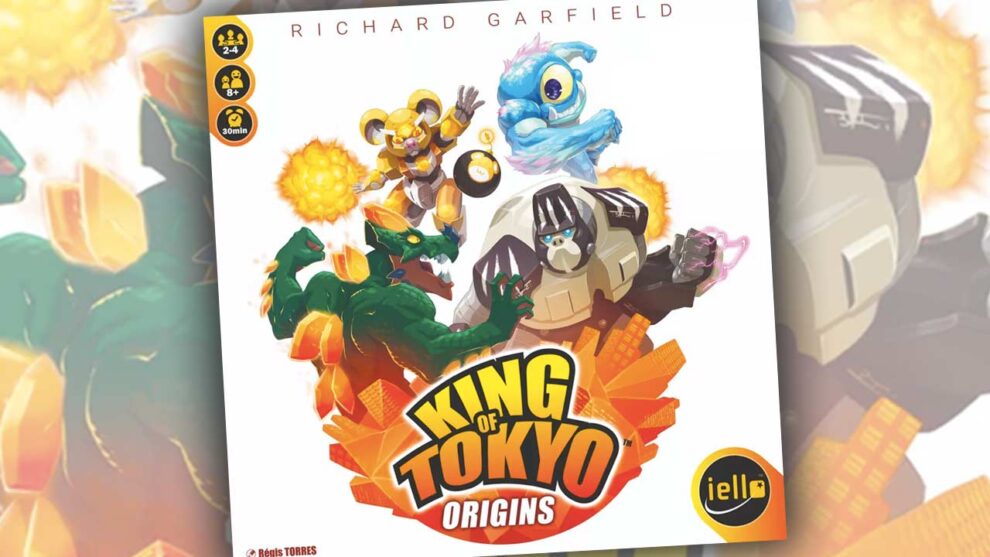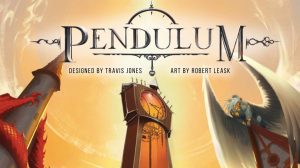King of Tokyo: Origins is a dice-chucking game that pits monster against monster in the age-old battle for Japan’s biggest city. The winner will either be the first person who reaches 20 points, or be the last monster standing.
Set Up
All players take a cut-out of a monster and sets it in the plastic stand. They then take the accompanying monster’s score tracker, setting the wheel in the upper left (Points) to zero and the wheel in the lower right (Health) to 10.


Set the board on the table in reach of all players—or don’t. The board only has a circle for the attacking monster to stand in. That’s all. Simply placing your monster in the middle of the table will have the same effect.
Shuffle the deck of cards. Throughout the game, you’ll be able to purchase these to gain either a temporary or permanent bonus. Place three cards face-up and the remaining cards to the side.

Randomly choose a starting player and give them all six of the large six-sided dice.
Playing the Game
The active player rolls all six of the dice, then chooses which to keep and which to re-roll. You can re-roll up to two times during your turn, even re-rolling dice you previously chose to keep as is.
Each die has the same six faces:
- Hearts, which increase your health (to a maximum of 10).
- Claws, which inflict damage on the monster currently in Tokyo.
- Lightning Bolts, which earn you green power cubes. These can be traded in for the face-up monster cards, based on the cost in the upper left of each card.
- Numbers 1, 2, and 3, which can grant you points. Three of any number give you the base number of points. (e.g., three 2s will give you 2 points.) Each matching number thereafter earns you one additional point. (four threes will get you 3+1 = 4 points)

When a player’s monster is in Tokyo, their damage rolls affect all the other players. (Roll 3 Claws and everyone else takes 3 damage from their Health total.) All players outside of Tokyo roll damage only for the monster in Tokyo.
If your monster stays in Tokyo through all the other players’ turns, you’ll score 2 points at the start of your next turn. However, any time your monster takes damage while in Tokyo—say, you’re dangerously low on health—you can choose to remove your monster. This causes the player whose turn has just ended to place their monster in Tokyo.
The game continues in this way, with players balancing the desire to inflict damage with trying to regain health so they don’t die and get eliminated.
Thoughts
Let me state at the outset that I am typically not a fan of games that involve dice—this despite being the Dungeon Master for my gaming group. I prefer the crunchy decisions that come in games without any luck factor, say a great abstract game like Ingenious or Tak, or open decision games like Paladins of the West Kingdom and Terra Mystica. Chucking dice feels like I’m throwing away choices I’d rather make myself.
King of Tokyo: Origins does mitigate that somewhat by allowing you to not only roll six dice, but by allowing you to re-roll and re-re-roll those dice in a single turn. While you’re certainly not guaranteed to get the die faces you were hoping for, by your third roll you should have a better set of dice to work with than you started with.
I may not be a fan of dice games, but the others in my gaming group are. When I had the chance to review the King of Tokyo games, I knew they would like it.
I also promised myself I would keep an open mind. And I did.
I’m not about to take a deep dive into dice games, but I have enjoyed our King of Tokyo sessions. The game presents a (very) few interesting decision points, even if they’re ones kids can handle. More importantly, though, the time spent playing has seen a lot of laughter around the table, which is the sign of a good time.
The one downside to King of Tokyo: Origins is that there are no differences between the four monsters. Sure, the monster cards you can trade in your power cubes for can change things a bit, but the monsters themselves are very two-dimensional: They’re generically interchangable. In the photo of two of the monsters (above), even though Mechamster is throwing bombs, they don’t exist in the game.
King of Tokyo: Origins is probably best played with younger kids. I think anyone older will tire of the bland sameness of the monsters. In that case, you should look at the King of Tokyo: Monster Box.











Add Comment